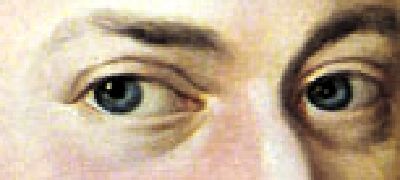|
<<< << -- 2 -- Thomas Larson HIDE AND SEEK -- >> >>>

In Krafft's depiction, some 28 years after her subject's death and nearly 40 years after the time of the portrayal, we see the clean, perhaps dusted skin of Mozart's face; the silver-grey wig, like fur of a domesticated mink, its twin curls stacked and slanted rakishly above his right ear; that bold, giddily repressed look on his face, sauced by his own genius or surprised, as we are, that the painter has intercepted a smirk whose target will always elude us. Krafft seems to have posed and dressed Mozart just so. His outfit, hair, and bearing are imperial -- the puffed-up chest also feels intended, though untrue to the composer's scrawny physique (he did balloon up from living high in his thirties); the marks from smallpox that disfigured his face are gone. Still, she embodies the gallant boy-man well. The pronounced nose anchors an indomitable face; the sexualized lips speak of recent baby-making with Constanze; the forehead is cleared of its headache; the arching eyebrows slough off his stubborn depression; and the eyes, wide awake and steely clear, are more confident than his letters let on: Mozart was bedeviled by a lack of confidence others had in him, though he himself was supremely self-assured. He had soaked up the wild adulation and bitter jealousy his talent inspired; no one, after all, really knew how to regard his genius for improvising melody. In later life, he was plagued by debt, not only because he was profligate but also because it took far too long for him to receive a paid position as a composer. He was -- and he grew to loathe the circus act even as he free-lanced it -- a reliable showman who composed and played concerti that spotlighted his facility, who wrote arias to flaunt singers he liked and who, for a song, over-adored him. One of Mozart's desires, so he told his father, was to write performable music for orchestras and be paid a princely sum as a Kapellmiester or court organist for his labor.

Detail of Mozart's eyes from Barbara Krafft's portrait
|
Krafft's image cannot be the person, of course. Such a view of any artist, let alone one as mercurial as Mozart, is unpaintable. And yet, just as the photo of Albert Einstein with his electric shock of white hair is him or the duplicated silk-screening of Marilyn Monroe by Andy Warhol is her, Krafft's rendering has become the image we accede to -- less for its psychology and more for its commercial appeal: a useful image that appears on CD covers, Mostly or Mainly Mozart festival programs, Viennese lager labels, relaxation tape boxes issued by 'Mozart for Mothers-To-Be', and so on. Perhaps Constanze, who outlived her husband by 50 years and would have known Krafft, urged the artist to recall Amadeus as she had treasured him from 1781, the idealistic, vain, flowering composer in his mid-20s. Krafft upholds this family-promulgated myth about Mozart -- the Christ-like pippin, eternally on tour, be-wigged by Papa. All her adult life Constanze continued Leopold's infantilization of the composer. The reasons that she exaggerated Wolfgang's puerile nature are numerous, Mozart biographer Maynard Solomon writes, but they boil down to her profiting off his legend and his music's growing public adoration while her second husband prepared a massive two-volume 'official' biography of the man he had replaced. But never mind these speculations. Mozart has stopped by the artist's atelier to bestow something less than authentic about himself on the painter's eye.
Continue >>
Copyright © 8 April 2007
Thomas Larson, California USA

|

